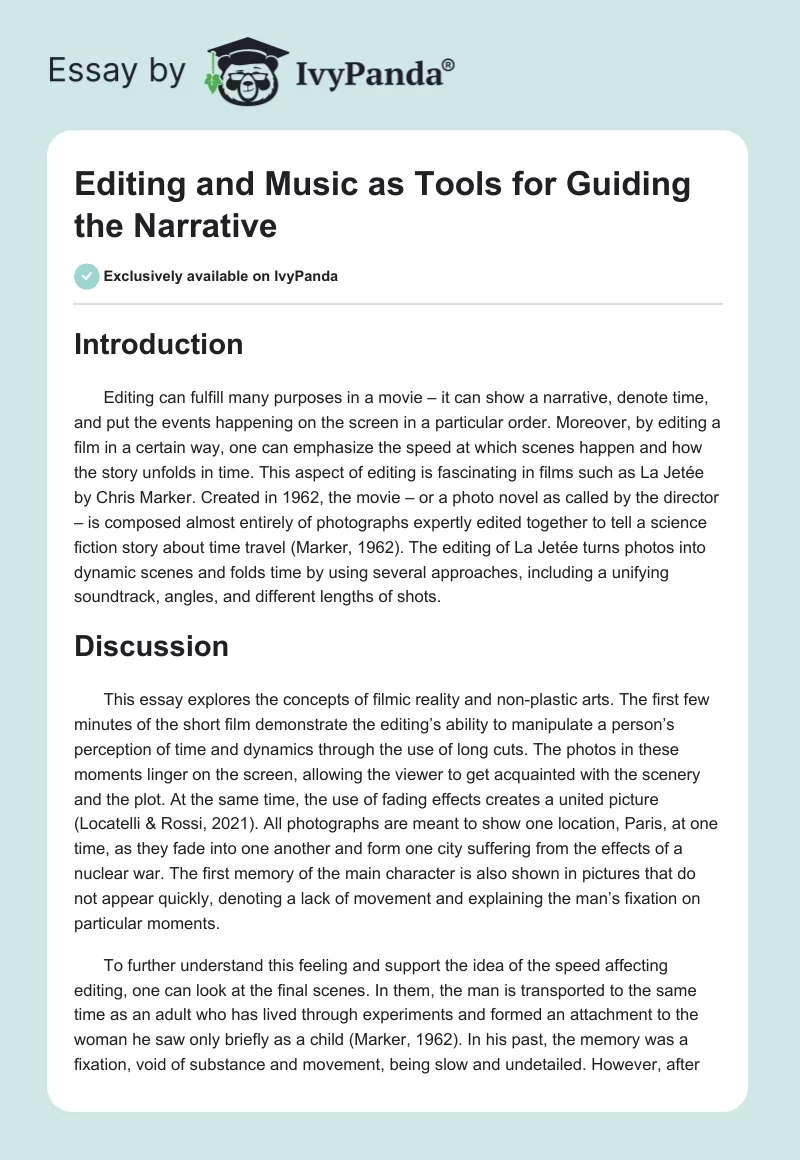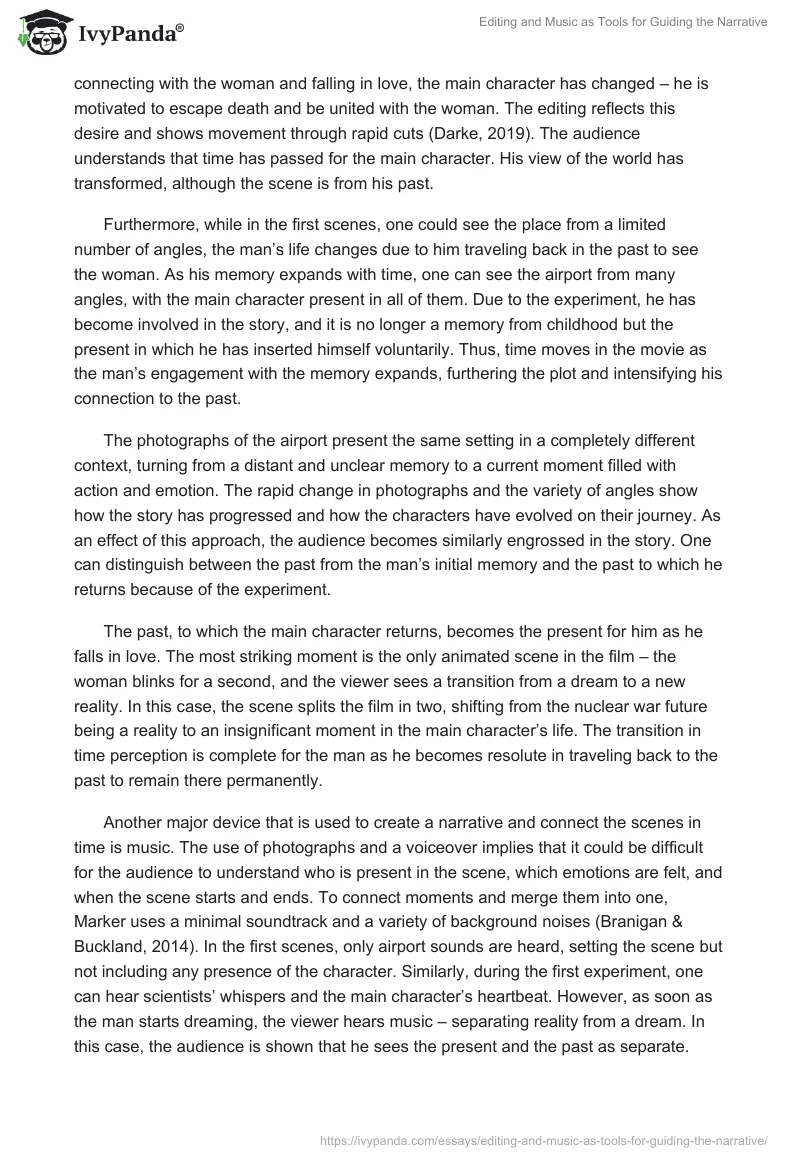Introduction
Editing can fulfill many purposes in a movie – it can show a narrative, denote time, and put the events happening on the screen in a particular order. Moreover, by editing a film in a certain way, one can emphasize the speed at which scenes happen and how the story unfolds in time. This aspect of editing is fascinating in films such as La Jetée by Chris Marker. Created in 1962, the movie – or a photo novel as called by the director – is composed almost entirely of photographs expertly edited together to tell a science fiction story about time travel (Marker, 1962). The editing of La Jetée turns photos into dynamic scenes and folds time by using several approaches, including a unifying soundtrack, angles, and different lengths of shots.
Discussion
This essay explores the concepts of filmic reality and non-plastic arts. The first few minutes of the short film demonstrate the editing’s ability to manipulate a person’s perception of time and dynamics through the use of long cuts. The photos in these moments linger on the screen, allowing the viewer to get acquainted with the scenery and the plot. At the same time, the use of fading effects creates a united picture (Locatelli & Rossi, 2021). All photographs are meant to show one location, Paris, at one time, as they fade into one another and form one city suffering from the effects of a nuclear war. The first memory of the main character is also shown in pictures that do not appear quickly, denoting a lack of movement and explaining the man’s fixation on particular moments.
To further understand this feeling and support the idea of the speed affecting editing, one can look at the final scenes. In them, the man is transported to the same time as an adult who has lived through experiments and formed an attachment to the woman he saw only briefly as a child (Marker, 1962). In his past, the memory was a fixation, void of substance and movement, being slow and undetailed. However, after connecting with the woman and falling in love, the main character has changed – he is motivated to escape death and be united with the woman. The editing reflects this desire and shows movement through rapid cuts (Darke, 2019). The audience understands that time has passed for the main character. His view of the world has transformed, although the scene is from his past.
Furthermore, while in the first scenes, one could see the place from a limited number of angles, the man’s life changes due to him traveling back in the past to see the woman. As his memory expands with time, one can see the airport from many angles, with the main character present in all of them. Due to the experiment, he has become involved in the story, and it is no longer a memory from childhood but the present in which he has inserted himself voluntarily. Thus, time moves in the movie as the man’s engagement with the memory expands, furthering the plot and intensifying his connection to the past.
The photographs of the airport present the same setting in a completely different context, turning from a distant and unclear memory to a current moment filled with action and emotion. The rapid change in photographs and the variety of angles show how the story has progressed and how the characters have evolved on their journey. As an effect of this approach, the audience becomes similarly engrossed in the story. One can distinguish between the past from the man’s initial memory and the past to which he returns because of the experiment.
The past, to which the main character returns, becomes the present for him as he falls in love. The most striking moment is the only animated scene in the film – the woman blinks for a second, and the viewer sees a transition from a dream to a new reality. In this case, the scene splits the film in two, shifting from the nuclear war future being a reality to an insignificant moment in the main character’s life. The transition in time perception is complete for the man as he becomes resolute in traveling back to the past to remain there permanently.
Another major device that is used to create a narrative and connect the scenes in time is music. The use of photographs and a voiceover implies that it could be difficult for the audience to understand who is present in the scene, which emotions are felt, and when the scene starts and ends. To connect moments and merge them into one, Marker uses a minimal soundtrack and a variety of background noises (Branigan & Buckland, 2014). In the first scenes, only airport sounds are heard, setting the scene but not including any presence of the character. Similarly, during the first experiment, one can hear scientists’ whispers and the main character’s heartbeat. However, as soon as the man starts dreaming, the viewer hears music – separating reality from a dream. In this case, the audience is shown that he sees the present and the past as separate.
Later, the sounds and the music start mixing as the man’s perception of time changes. As his travels allow him to go to the past, he no longer sees time in a linear way. He hears music and the scientists whisper as photographs of his travels to the past are shown on screen. This combination may signify that he is confused about what is real what is a part of the experiment, and which reality he is experiencing. The music is also present as the man travels into the future, and the audience can understand that this travel is a part of the experiment. At the end of the film, the two types of sounds – the airport noises and the music – merge as the man travels to his core memory for the last time. The reality signified by the loud plane noises and the man’s memory defined by music is united as time finishes its loop.
Conclusion
In conclusion, Marker uses editing and sound to bring life into the still pictures used in the film. The scenes are made more static or dynamic depending on the speed of cuts between them. At the same time, the audience can follow a timeline and separate the past, the present, and the future in the character’s story rather than in linear time through editing. As the man becomes more involved with the past and the woman from his memory, the shots become quicker, more emotional, and more engaged. The swift changes and the variety of angles imply that the man’s one idea of the past event grows into a fresh perception of the past as his new present. Similarly, the music and the noises enrich one’s understanding of what is seen as a part of an experiment and the man’s reality. In the end, the two are mixed to signify the change in how time has folded and the past, present, and future have become one.
References
Branigan, E., & Buckland, W. (Eds.). (2014). The Routledge encyclopedia of film theory. Routledge.
Darke, C. (2019). La Jetée. Bloomsbury Publishing.
Marker, C. (1962). La Jetée [Film]. Argos Films.
Rocatelli, V. B., & Rossi, C. (2021). Time oddity: Paradoxes and the gothic. Literartes, 1(15), 243-260.


